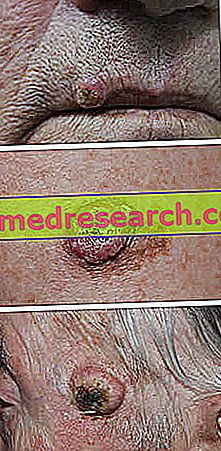Generality
The gas embolism is a pathological state in which an air bubble obstructs the normal flow of blood inside a vessel.

A gas bubble can enter the bloodstream following a poorly performed venous injection, hazardous diving, surgery, a blow to the chest, etc.
The symptoms are very disparate and strongly depend on which blood vessels are occluded by the gas bubble. The most serious complications occur when air embolism causes stroke, heart attack or respiratory failure.
For a correct diagnosis, the doctor first of all uses an objective examination and an analysis of the patient's medical history.
Therapy depends on the severity and causes of embolism.
What is air embolism?
Gaseous embolism is a pathological condition that occurs when one or more air bubbles block the flow of blood inside a blood vessel.
If the affected vessel is an artery, it is called arterial gas embolism ; if instead a vein is involved, it is called venous gas embolism .
MEANING OF EMBOLIA AND BUBBLES OF AIR
The term embolism identifies any presence, inside the blood vessels, of a mobile body unable to dissolve in the blood. This body, generically called embolus, can be a blood clot, a lump of fat, an air bubble etc.
Emboli are transported from the blood to a certain point, where they stop by partially or totally blocking blood circulation.
Air bubbles therefore have all the typical characteristics of emboli; consequently, moving within the vascular system, they can reach any part of the body and hinder blood circulation.
HOW MUCH IS A GASEOUS EMBOLY?
The presence of air bubbles circulating in the vascular system can be very dangerous, since the emboli could also reach the arteries of the brain, the coronary arteries that supply the heart muscle and the blood vessels that conduct the deoxygenated blood from the heart to the lungs.
- If the air bubbles end up in the arterial vessels of the brain, they could cause a stroke (an embolic ischemic type).
- If the bubbles reach the coronaries, they could give rise to a heart attack .
- If the bubbles arrive in the pulmonary artery or in one of its branches ( pulmonary embolism ), they could cause respiratory failure .
Epidemiology
The exact incidence of air embolism is not known; however it is a very rare pathological condition.
Gas embolism is one of the main causes of death among divers (sub).
Causes
Gaseous bubbles form inside the vascular system when the pressure conditions around a blood vessel exposed to a gas favor the entry of the latter into the vessel itself. In other words, if an artery or vein is in contact with the air and the surrounding pressure conditions allow it, atmospheric gases can penetrate into the vessel involved and form bubbles.
The formation of one or more air bubbles inside a blood vessel can occur at:
- Injections . If poorly used, syringes used for venous injections can lead to the introduction of air into the vascular system.
The gas embolism due to injections is very rare.
- Surgical procedures . During some surgical operations, the use of central venous catheters is used in the subclavian or jugular vein. Since in these regions the pressure conditions favor the entry of air into the vascular system (NB: the venous pressure is lower than the atmospheric one), the introduction of a catheter could represent a gateway for atmospheric gases. To try to prevent this inconvenience, doctors insert the catheter by positioning the patient supine and with the head sloping with respect to the bed surface ( Trendelenburg position ).
The surgical procedures most at risk of gas embolism are brain operations; according to an accredited scientific journal, the Journal of Minimal Access Surgery, 80% of brain procedures cause the formation of gas embolism, which, however, is then eliminated by the doctors before ending the operation.
- Lung trauma . Following a trauma to the chest that damages the lungs, artificial ventilation may be required. If the trauma resulted in a vascular injury, the air introduced with artificial ventilation could seep into the injured vessel and form bubbles.
- Scuba diving . If a diver stays too long under water, he accumulates a lot of nitrogen in his own blood and in his tissues, as the nitrogen is contained in the air of the breathing tanks.
The presence of massive doses of nitrogen and the non-elimination of the latter can lead to the formation of gaseous bubbles in the blood or tissues. This process is also known as decompression sickness .
NB: decompression sickness can also occur following exposure to high pressures, for example when diving in the depths of the sea.
- Pulmonary barotrauma . Barotrauma is any lesion caused by a difference in pressure between the air contained in a cavity of the body and the environment surrounding that cavity. If a barotrauma occurs at the level of the lungs (pulmonary overdistension or pulmonary barotrauma), it could happen that the pulmonary alveoli are damaged and the air breathed from that moment on enters the arterial vessels, giving rise to an arterial gas embolism.
The main cause of pulmonary barotrauma is that the surface rises too fast during a scuba dive.
- Bomb explosion . A person located near a bomb explodes undergoes a sudden pressure jump, which can lead to damage to some organs and tissues in contact with the air, such as ears, alveoli or the first part of the digestive tract . In such conditions, it is possible to develop a gas embolism.
- Sexual relations (in women) . If the vagina, uterus or placenta have a small lesion, it is possible that during sexual intercourse (especially oral sex) the air will penetrate inside the injured vessels.
Embolism due to sexual intercourse is more frequent among pregnant women, as these could present small wounds on the placenta.
Symptoms
The gas embolism does not always present itself with the same symptomatology: some patients, in fact, suffer mild disorders or do not accuse them at all; while others have serious problems.
Depending on where the air bubbles are, the symptoms and signs of air embolism could be:
- Dyspnea on exertion and dyspnea at rest. The so-called "air hunger" is typical of cases in which air bubbles are found in the pulmonary artery or in one of its branches (pulmonary embolism).
- Palpitations, chest pain, cough and cough with blood ( hemoptysis ). They are typical disorders of pulmonary embolism.
- Cyanosis . It is a characteristic sign of pulmonary embolism.
- Dizziness and dizziness
- Fainting
- Nausea and vomit
- Excessive sweating
- Hypotension
- Sense of generalized fatigue
- Irregular heart beat and tachycardia. It can occur either due to a pulmonary embolism or due to air bubbles in the heart.
- Mental confusion, cognitive impairment and personality changes. They are typical of when air bubbles have reached the brain ( embolic ischemic stroke )
- Paralysis, sense of weakness, loss of coordination and numbness. These are all signs of an embolic ischemic stroke.
- Visual difficulties. Typical of the embolic ischemic stroke.
- Loss of knowledge
- Convulsions
- Tremors
- Acoustic problems
- Altered tactile perception
- Dizziness
TYPICAL SYMPTOMS OF GASEOUS EMBOLIA ASSOCIATED WITH DECOMPRESSION DISEASE
Some factors favor decompression sickness in scuba divers:- Patent oval foramen (heart defect)
- Cold water
- Dehydration
- Obesity
- Fly a few hours after the dive
- Old age
- Go too deep
- Stay too underwater
- Perform multiple dives on the same day
The typical symptoms of air embolism associated with decompression sickness are the following: dizziness, blurred vision, bleeding from the mouth, paralysis, a feeling of weakness, convulsions, loss of consciousness and shortness of breath.
WHEN TO REFER TO THE DOCTOR?
If a person complains of a symptomatology similar to that reported above, it is advisable to contact a hospital immediately. If it is serious, in fact, air embolism requires timely medical intervention, because otherwise it could lead to death.
COMPLICATIONS
Among the possible complications, there are the most serious consequences of stroke (total paralysis of the motor muscles, serious difficulty in speaking and swallowing, memory loss, etc.), heart attack (ventricular fibrillation, severe heart failure, etc.) and of pulmonary embolism (severe respiratory insufficiency and pulmonary hypertension).
Diagnosis
To diagnose air embolism, they are of fundamental importance:
- The objective examination, during which the doctor analyzes and evaluates the symptoms accused by the patient.
- The examination of the clinical history, which serves the doctor to establish what may have triggered the appearance of the ongoing disorders. For example, the fact that, before the onset of symptoms, the patient has suffered a blow to the chest could be an important piece of information; as well as the fact of frequently diving or having performed independently (incorrectly) a venous injection of some drug.
- The ecodoppler . The ecodoppler allows to analyze in real time the anatomical and functional situation of the blood vessels. Therefore it clarifies what is the exact dynamics of the vasal blood flow and if, inside the vessels, there are occlusions or obstacles (including air bubbles). This is a completely bloodless procedure.
- CT scan (or computerized axial tomography ). The CT scan is able to detect abnormalities and occlusions that could affect blood vessels. It is considered an invasive examination, as it exposes the patient to a minimal dose of ionizing radiation.
HOW TO FIND THE PRESENCE OF AIR BUBBLES DURING SURGERY OPERATIONS?
To realize if, during a surgical procedure, air bubbles have formed, the doctors constantly monitor the following parameters of the patient: frequency and characteristics of breathing (particular noises, etc.), blood pressure, heart rate and particular noises emitted by the heart.
Early diagnosis of a post-surgical air embolism is crucial to avoid unpleasant consequences.
Treatment
Usually, small air bubbles dissolve in the bloodstream in a completely spontaneous way. However, it is very important to immediately remedy the causes that caused its formation, in such a way as to prevent it from forming others.
If the gas bubbles are large, or the causes of gas embolism are particularly serious, things are more complicated. In these situations, in fact, it may be necessary to resort to surgery for the removal of the bubbles or to hyperbaric oxygen therapy .
WHAT TO DO IF THE GASEOUS EMBOLIA HAS HAD SITE AFTER DIVING? NOTES OF UNDERWATER MEDICINE
If air embolism occurs following a scuba dive, it is necessary:
- Lay the patient down with the head lower than the feet (Trendelenburg position) and the body facing the left side
- Give him oxygen
- Take it as soon as possible to a hospital with a hyperbaric chamber (hyperbaric oxygen therapy).
IPERBARIC ROOM
The hyperbaric chamber (or chamber for hyperbaric therapy ) is a room in which it is possible to breathe 100% pure oxygen at a pressure higher than normal.

The session usually lasts a couple of hours: this time is used to restore normal blood pressure (which after a dive could be altered) and to eliminate any air bubbles present in the body.
At the end of the treatment, it is important that the pressure inside the chamber is brought back to normal gradually. If, in fact, the return to normal pressure levels is sudden, it is likely that the patient will suffer (NB: this is the same situation in which a diver finds himself climbing the surface too quickly).
Prevention
To prevent a dive from becoming life-threatening, it is good practice:
- Limit time spent underwater so as not to accumulate too much nitrogen in the blood and tissues.
- Avoid going too deep, because the deeper you go down into the sea, the higher the pressure and the greater the risk of gas embolism.
- Avoid diving if you suffer from a cold, cough or chest disease.
- In the 12-24 hours after surfacing, do not travel by plane and do not go to high altitudes.
- Go back to the surface slowly.
Prognosis
Without adequate treatment, air embolism characterized by large bubbles is fatal.



